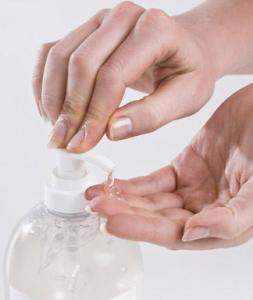
The H1N1 ("swine") flu pandemic is in full swing, and we can expect many more cases this fall as kids go back to school. I'm still anxiously watching this virus and hoping that it will remain relatively mild (as flu pandemics go). But it's possible that it could become more severe with time, since flu viruses are well-known for their tendency to mutate. My sister in law just recovered from the flu, and even though she did fine, she was pretty miserable, so it's a good bug to avoid in any case.
So this is a good time to review the top tips for prevention at school. The top three tips are: wash, wipe, and clean!
Tip #1: Wash hands! Yes, I know you're hearing this from everyone, but it's worth repeating. This is a great time to teach your child good hand-washing skills and remind them of how important it is. I recently heard the tip to have your child sing "Row, Row, Row your Boat" to make sure he or she is washing for long enough - it works!. Be sure to wash around the fingernails, in the web spaces of the fingers, and the base of the wrists. These zones are often missed and germs can hide there. "Anti-bacterial" soaps are ineffective against this virus and contain toxic chemicals, so the best choice is regular soap and water.
Tip #2: Have alcohol-based hand sanitizers or hand wipes in convenient places for use between hand washings. For example, after riding the bus, or for quick use in between classes. These products work to kill viruses by drying them out. If schools have 'no alcohol' policies, they should make an exception for hand sanitizers.
Tip #3: Clean surfaces regularly. Desks, tables, chairs, computer keyboards, and doorknobs are great at transmitting disease since the virus can survive on these surfaces for hours. There are five categories of chemicals that the Centers for Disease Control and Prevention (CDC) recommends for killing viruses on surfaces: (1) alcohol-based products, (2) diluted bleach, (3) hydrogen peroxide, (4) soap or detergent, and (5) iodine-based disinfectants. I usually don't recommend the iodine products because they stain everything brownish-orange. Bleach needs to be used carefully since it can be toxic, and it can also irritate the airways and even trigger asthma problems in sensitive individuals. If you decide to use bleach, it should be diluted with water so it's only a 10% bleach solution.
People have asked me about using lemon juice, vinegar, baking soda, or other natural cleaning products. Although I believe it's likely that cleaning with these natural substances will kill the virus, I haven't seen any evidence, so I'm a bit cautious. However, if you also add a squirt of soap or dish detergent to the mixture and give the surfaces a good wipe-down, that should do the trick.
Stay healthy this fall!
***This post originally appeared on the NRDC Switchboard.
Gina Solomon has been a Senior Scientist at NRDC for twelve years, and her work is focused on protecting people from toxic chemicals. She has worked on preventing mercury and lead poisoning, researching levels of diesel exhaust inside school buses, working to ban the most dangerous pesticides, getting endocrine disrupting chemicals out of consumer products, and helping to answer people's questions about their health and the environment.

